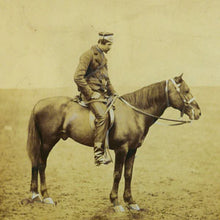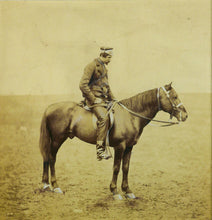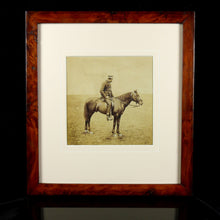Major Cathcart, Deputy Assistant Adjutant General, Light Division, Crimea, 1855
- Regular price
- £890
- Sale price
- £890
- Regular price
-
- Unit price
- /per
Adding product to your cart
Overall: 33cm (13in) x 30cm (12in)
Salt print. Roger Fenton equestrian portrait photograph of the Hon. Augustus Murray Cathcart, with contemporary watercolour and gouache highlight, mounted facing right. Agnews’ Fenton exhibition catalogue (1855) no. 34. Image: 16.5cm x 16cm. Contained in modern mount and glazed frame.
Colonel Hon. Augustus Murray Cathcart (1830-1914) was the son of General Charles Murray Cathcart, 2nd Earl Cathcart and Henrietta Mather. He was commissioned into the 87th (Royal Irish Fusiliers) Regiment of Foot in 1846. In 1852 he took part in funeral procession of the the 1st Duke of Wellington as part of the escort to the Duke’s personal guidon.
In the Crimea he served on the staff of his uncle Sir George Cathcart, commanding the 1st Brigade, and was with him when, in great confusion at the Battle of Inkermann, Sir George was shot dead while leading an uphill bayonet charge by fifty men of the 20th Foot, in order to support the Guards. Augustus was serving as Deputy Assistant Adjutant General to the Light Division commanded by General Sir William John Codrington (qv) when photographed by Fenton. He married the Hon. Jean Mary Orde-Powlett, daughter of the 3rd Baron Bolton of Bolton Castle in 1866 and exchanged into the Grenadier Guards the same year.
Roger Fenton (1819-1869), noted as one of the first war photographers, was a practising solicitor with an interest in painting, when he learned the art of photography around 1850. Within a short time he emerged as a well-known figure in the British photography scene, becoming the honorary secretary of the Royal Photographic Society, of which he was a founding member, and the first official photographer of the British Museum. The new medium of photography brought him into contact with technologically minded elites, including Prince Albert and the Duke of Newcastle, Secretary of State for War, who urged Fenton to go to the Crimea to record events. The publisher Thomas Agnew & Sons commissioned Fenton to document the Crimean War, making first use of such on campaign. Using glass plate negatives and the wet collodion process, Fenton captured camp life, panoramas of battle scenes, and individual and group portraits of officers and soldiers. The negatives were then shipped back to Britain where they were used to make prints in two different ways – the salted paper print and the albumen print. The prints were later exhibited in London by Agnew in October 1855, with the first prints being offered for sale to the public the following month. Others were published at intervals over the next four to five months until all were available.








